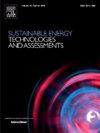Pretreatment methods for enhanced biomethane production from crop residues: Progress, challenges, and future perspectives
IF 7.1
2区 工程技术
Q1 ENERGY & FUELS
Sustainable Energy Technologies and Assessments
Pub Date : 2025-03-01
DOI:10.1016/j.seta.2025.104269
引用次数: 0
Abstract
The increase in the global population has caused a rise in the agricultural practice, consequent to increased generation of Crop residues (CR). CR are readily available and less expensive renewable lignocellulosic resource, which is getting more attention in the sector of renewable energy and sustainable development. Pretreatment is an important step in transforming CR into high value chemicals through suitable process. To break down the lignocellulosic CR’s resistance and enhance its disintegration into lignin, cellulose, and hemicellulose, a range of pretreatment techniques are used. This review explores the use of advanced pretreatment technologies for CR aimed at improving biomethane production. Discusses the characteristics of CRs, evaluates different pretreatment approaches—physical, chemical, biological, and hybrid methods—and assesses strategies and potential new approaches for integrating waste and energy production. Lignocellulosic wastes, primarily CR stands out the most efficient biomass source for biomethane production because of their abundant availability, high carbon/nitrogen ratio and low ash content. In case of pretreatment methods, hybrid/combined pretreatment emerges as the most promising option when compared to single pretreatment methods, because it offers effectiveness and flexibility in enhancing the biomethane production.

利用作物残留物提高生物甲烷生产的预处理方法:进展、挑战和未来展望
全球人口的增加导致了农业实践的增加,从而增加了作物残留物(CR)的产生。CR是一种易得且价格低廉的可再生木质纤维素资源,在可再生能源和可持续发展领域受到越来越多的关注。预处理是通过合适的工艺将CR转化为高价值化学品的重要步骤。为了分解木质纤维素CR的抗性并促进其分解为木质素、纤维素和半纤维素,采用了一系列预处理技术。本文综述了先进预处理技术在CR中的应用,旨在提高生物甲烷的产量。讨论了cr的特点,评估了不同的预处理方法——物理、化学、生物和混合方法——并评估了整合废物和能源生产的策略和潜在的新方法。木质纤维素废弃物,主要是CR,由于其丰富的可利用性、高碳氮比和低灰分含量,是生产生物甲烷最有效的生物质来源。就预处理方法而言,与单一预处理方法相比,混合/联合预处理成为最有希望的选择,因为它在提高生物甲烷产量方面具有有效性和灵活性。
本文章由计算机程序翻译,如有差异,请以英文原文为准。
求助全文
约1分钟内获得全文
求助全文
来源期刊

Sustainable Energy Technologies and Assessments
Energy-Renewable Energy, Sustainability and the Environment
CiteScore
12.70
自引率
12.50%
发文量
1091
期刊介绍:
Encouraging a transition to a sustainable energy future is imperative for our world. Technologies that enable this shift in various sectors like transportation, heating, and power systems are of utmost importance. Sustainable Energy Technologies and Assessments welcomes papers focusing on a range of aspects and levels of technological advancements in energy generation and utilization. The aim is to reduce the negative environmental impact associated with energy production and consumption, spanning from laboratory experiments to real-world applications in the commercial sector.
 求助内容:
求助内容: 应助结果提醒方式:
应助结果提醒方式:


